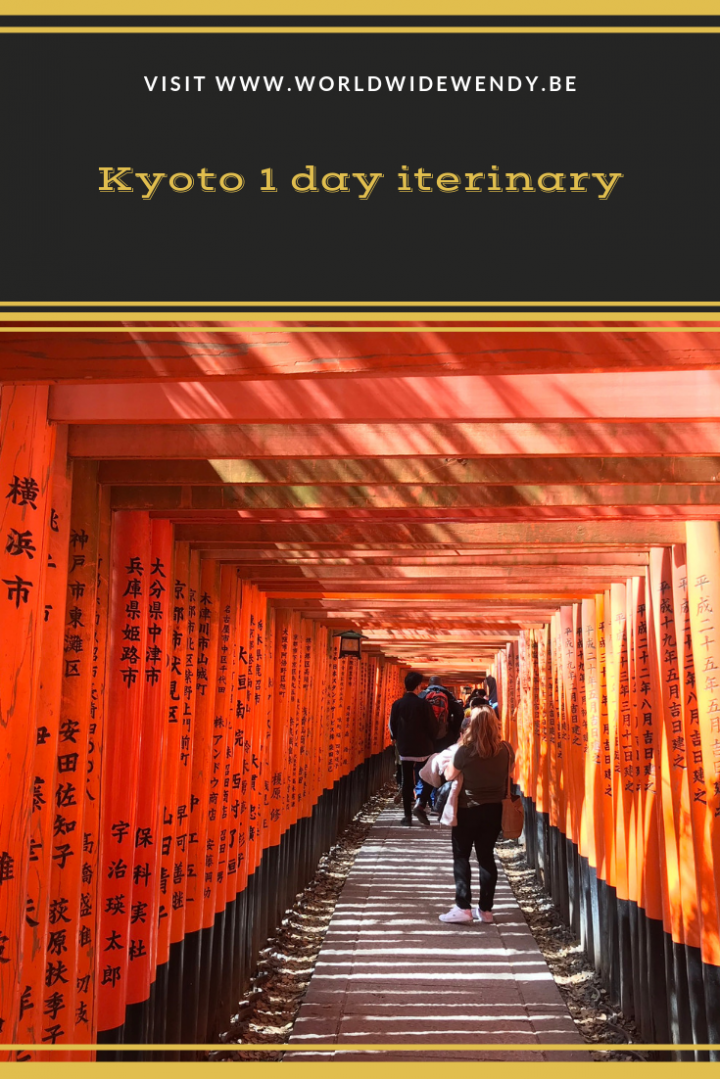During our 3 day citytrip to Tokyo, we went on a daytrip to Kyoto to discover the most important things to do in Kyoto. Traveling by the famous Japanese bullet train, Kyoto is just 2 hours from Tokyo. This Kyoto 1 day itinerary will help you to make the best of it.
A brief history of Kyoto
For over 1000 years, Kyoto was the capital of Japan. It came to an end in 1868, when Tokyo assumed that role.
Kyoto contains a wealth of cultural heritage and was therefore not bombed during the 2nd World War. It is therefore the only large city where you will find a mix of pre-war and new buildings. The old Kyoto is Unesco World Heritage.
Today, the city has 1.5 million inhabitants, and it is the cultural centre of Japan. There are 1600 Buddhist temples, 400 Shinto shrines, and many palaces and Japanese gardens. You can only visit a few things to do in Kyoto during your one day trip from Tokyo, but it is a city not to be missed if you are traveling through Japan.

From Tokyo to Kyoto on the bullet train
Japan is known for its perfectly organised railway transport. During your stay in Japan, you must try and experience the bullet train or shinkansen yourself.
Our train left from Shinjuku station, the largest station in Tokyo. Fortunately, we had booked an organised daytrip, as I can guarantee you will get lost the first time you visit the gigantic Shinjuku station.
We were brought to the correct entrance, and were picked up by a local guide. She escorted us to the correct platform. We were very keen to see if those trains were really as punctual as they claim! And the proof was plain to see: it arrived the very second it was scheduled! The Belgian railways can learn a lot here!
We had booked first-class tickets, and took our seats in a squeaky-clean, comfortable carriage. Wide chairs that can tilt all the way back complete with footrest, free wi-fi, and a USB connection ensured we had a very pleasant trip on our way to see the best things to do in Kyoto.
It was our first clear day in Japan, which meant that we enjoyed a fantastic view of the iconic Mount Fuji for kilometres on end.
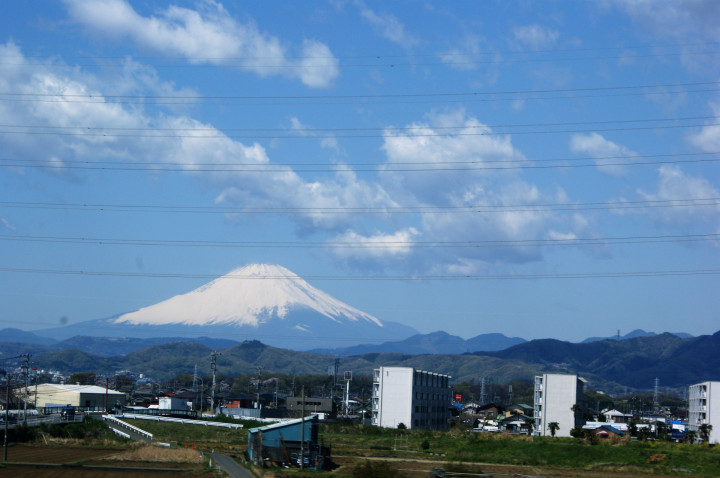
At the station, another guide was waiting to bring us to the right exit.
If you want to take the bullet train from Tokyo to Kyoto, look for the Tokaido Shinkansen. This 515-kilometre long high-speed track connects Tokyo and Shin-Osaka. You will pass Kyoto on the way.
Keep in mind that as soon as you hear your stop announced, you have to get up. The train often only stops for a couple of seconds.
IKyoto 1 day itinerary
Fushimi Inari -Taisha tempel
The first stop of the day brought us straight to the most famous thing to do in Kyoto, the Fushimi Inari-taisha. If you have ever seen photographs of Japanese shrines, there is a good chance it was this Shinto shrine, as it is close to being the most-photographed shrine in Japan.
The orange-red wooden torii entrance gates are beautiful. There is a good reason the temple is included on the UNESCO World Heritage List, and it is one of the highlights of Kyoto.

However, don’t be fooled by the photos on Instagram. They will show you desolate views and it looks as though you’re the only person in the world. Not really! In real life, it is very busy, and you have to just shuffle along with the throngs of people under the torii.
The shrine complex is enormous, and consists of 32,000 holy torii, spread over an area of 4 km2 on the side of the Inari mountain. You start at the base with a number of small torii. The further you walk, the larger they become. And depending on the route, you can visit different shrines.

The torii are gifted by Japanese companies who in doing so thank the gods of prosperity. The construction of the shrine was started in 711, in a different location. In 816, the shrine moved to its current site. In 1499, the complex was first opened to visitors.
The shrine lies outside of the city centre, but it is easy to get to by taxi or train. From the main station in Kyoto, take the JR Nara line, and get off at Inari.
And of course, you can make another wish here. Throw a coin in the designated basket, make your wishes, clap your hands twice, and bend over twice. If you’re not sure, have a look at what the Japanese people do.
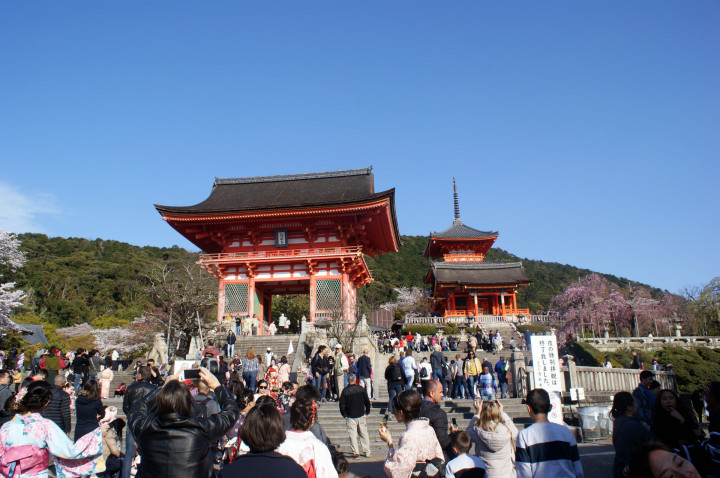
The cherry blossoms make it an even more memorable visit during your one day in Kyoto.
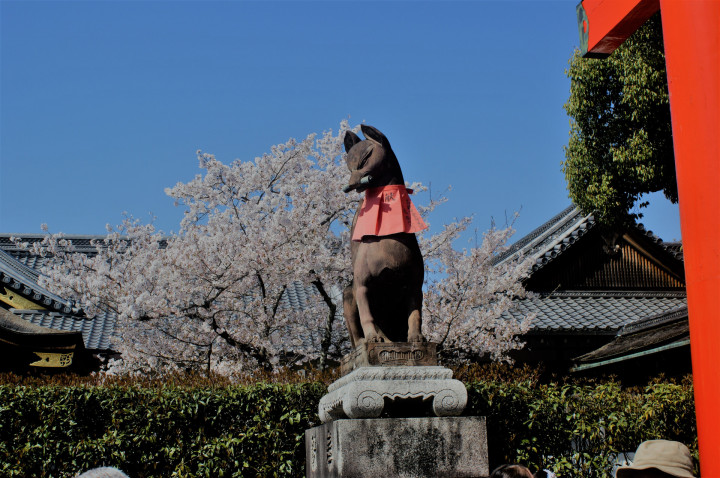
Geisha-spotting in Gion
Gion is one of the only remaining geisha districts in Japan. The neighbourhood is in sharp contrast with the hypermodern Tokyo. You can get a taste of the past here. There are narrow alleyways, typical Japanese houses made of wood, and cute tea houses and restaurants. You regularly meet geishas. You recognise them immediately by their silken kimonos, white socks, and slippers. They often wear a wig, and their face is snow-white with bright red lips.
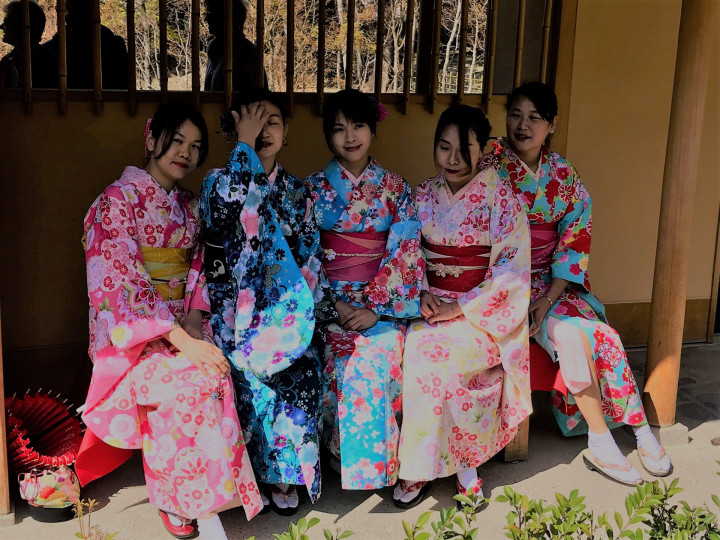
In the past, geishas were companions who entertained their “guests” with intelligent conversation, dancing, music, or singing. The patron of a geisha is called a danna, someone who provides financial support. These women were the symbol for beauty and refined culture. They were intelligent ladies, and not prostitutes. A geisha makes about 100 euro per hour, and will receive a few hundred on top as a tip at the end of the evening. Engaging a geisha is expensive business.
Sanjūsangen-dō
This Buddhist temple of the Tendai sect was founded in 1164. The building isn’t very interesting on the outside. It is a 120-meter-long wooden pavilion with unassuming decorations. The original temple from 1164 was destroyed by fire, and rebuilt in 1266.
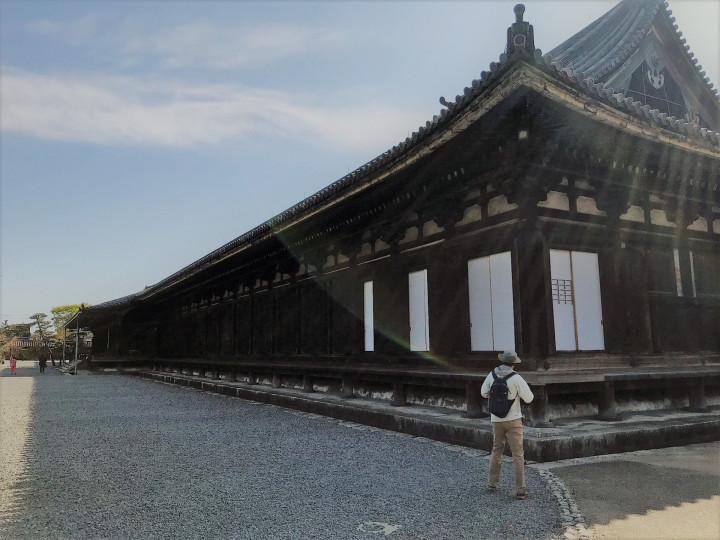
.However, the inside of the temple is impressive. There are 1001 life-size wooden statues. They are 1000 standing Buddhist deities, and one enormous sitting deity.
A total of 124 statues date back to the 12th century, and the other 876 were made in the 13th century when the temple was rebuilt.
Unfortunately, you are not allowed to take photographs inside, so you’ll have to make do with the photo I took of a poster.

Kiyomizu-dera tempel
This old Buddhist temple dates to the 8th century, and is situated at the foot of the rocks. It gets its name (Clear Water Temple) from the water spring that rises to the surface here. The temple is part of the Historic Monuments of Ancient Kyoto UNESCO World Heritage site, and one of the absolute things to do in Kyoto.


The complex consists of a wonderful orange pagoda and a temple. A number of stairs will bring you up to a terrace from where you will have a fantastic view of the surroundings and over Kyoto. We were there in April, when the cherry blossoms were in full bloom, and it was beautiful.
You can take a short walk to a second, smaller pagoda a little further on.
Behind the temple lies the so-called Love Stone. If you are here with your partner, you have to touch the stone together. Eternal love guaranteed!



You can pray for good fortune at the temple. Throw a coin, clap your hands twice, and bend twice while making your wish.
Just outside the temple complex lie a few interesting streets with souvenir shops and food stalls. Be sure to taste a cherry blossom ice cream.

We had only time to visit the above temples and the Gion district during our one day in Kyoto. Of course, there are many other things to do in Kyoto, and there is much more to discover.
If you have another day to spend in Kyoto, be sure to include these highlights in your Kyoto itinerary.
Kinkaku-Ji, the golden pavillion
This beautiful Zen Buddhist temple at the edge of a pond is included on the UNESCO World Heritage register. The temple was originally called Rokuon-ji, Deer Garden Temple, but because the walls were painted gold in 1950, it was renamed Kinkaku-ji, literally “Temple of the Golden Pavilion”.
The pavilion was built in 1337 by a rich shogun.
The temple survived many wars, but was set on fire in 1950 by a monk who then tried to commit suicide on the holy Daimon-ji hill. Because the temple was World Heritage, it was immediately rebuilt. It was painted gold, and it received its new name.
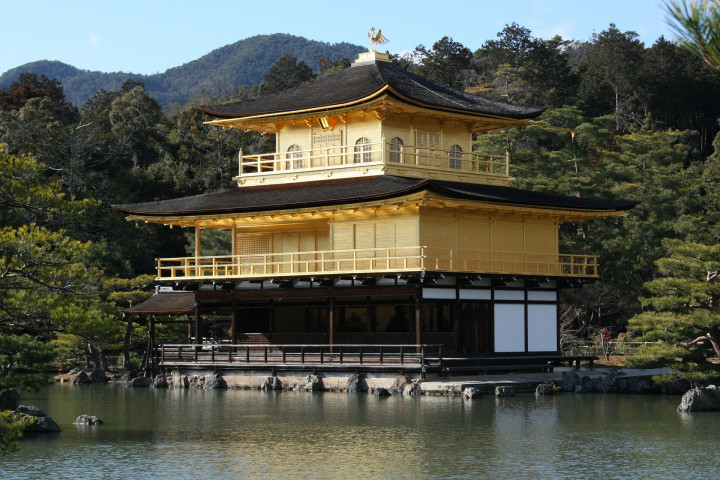
Picture by danad94d from Pixabay
Ginkaku-Ji, the silver pavillion
This Zen Buddhist temple from 1480 was initially the country house of the shogun. It became a temple after his death. As the golden pavilion has gold-coloured walls, you’d expect this one to be a silver-coloured. This is not the case however.
If you have time during your one day in Kyoto, you can wander around for hours in the adjoining garden and woods.
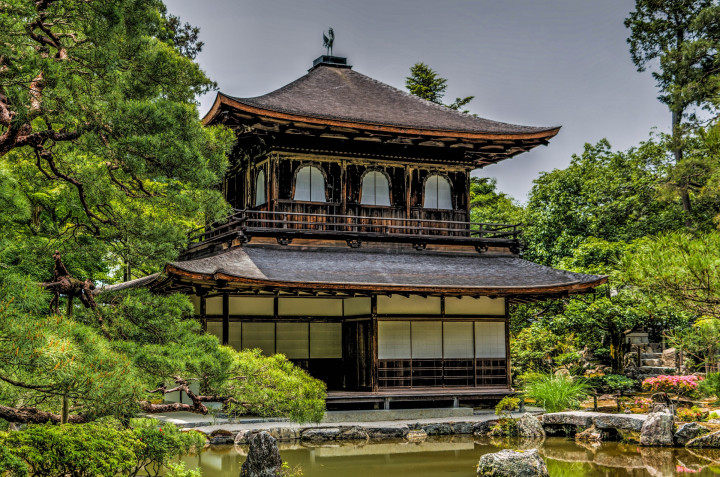
Picture by Michelle Maria from Pixabay
Kyoto Imperial Palace
The Imperial Palace of Japan in Kyoto was the residency of the emperor until 1868. As the capital moved to Tokyo, the imperial family moved too. The building is still a palace, and the grounds include some breath-taking gardens.
The old palace was destroyed by fire. The current building dates to the middle of the 19th century.
Until 1915, the enthronement ceremonies of the new emperor still took place at the palace.
Saihō-ji Temple
This fascinating temple lies in the west of Kyoto, and is also called Koke-dera or moss temple as it is completely covered in moss.
People think that the temple once was one of the villas of Prince Shotoku.
The adjoining garden is said to be the most beautiful garden in the world. It is also included on the UNESCO World Heritage list, and on the List of Historic Sites and Places of Scenic Beauty of Japan.
Visitors need to be at least 12 years old, and you need to book your visit beforehand.
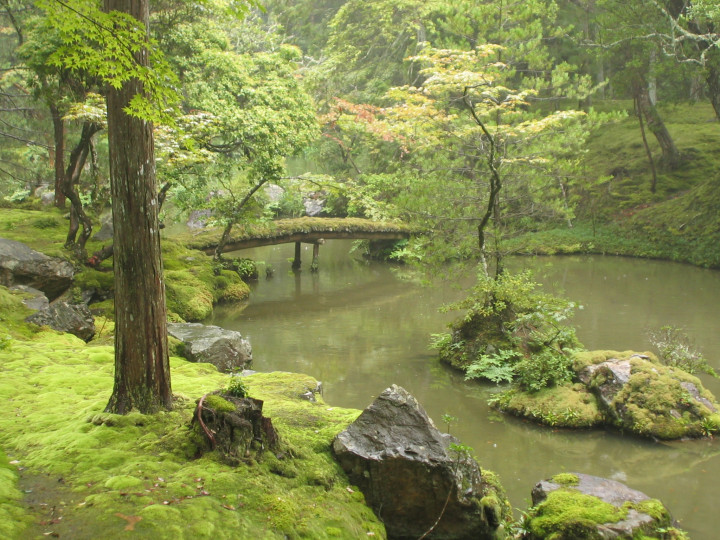
If you have more time, you could follow the 3 day Kyoto itinerary
Traveling by Bullet Train in Japan
At the end of our day trip from Tokyo to Kyoto, we took the bullet train back to Tokyo. I’m not a big fan of rail travel at home, but it is highly recommended in Japan. The Japanese bullet trains are tidy, comfortable, and above all, punctual!
We had to return to Tokyo as our cruise would leave from there.
Naturally, you can travel to other places in Japan from Kyoto. If you are planning to make a lot of rail journeys in Japan, you can consider buying the Japan Rail Pass. You can choose a pass for one, two, or three weeks, and if you only visit a particular part of Japan, you can book a regional pass. Find out which trains you would like to take, and then calculate whether it is worth buying the JR Pass. You can find more information on the site of Japan Rail Pass .
Routemap
Find your way in Kyoto thanks to this detailed map.
Do you know of any Kyoto highlights that I did not include in this post? Share them in the comments below.
Like it? Pin it!
